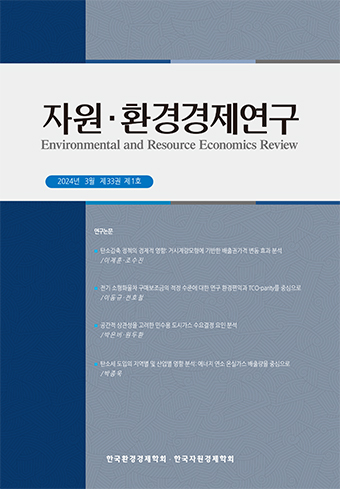Research Paper
Abstract
References
Information
In this paper, we conducted panel data analysis considering spatial correlation between regions, which were not considered in previous papers in analyzing the causes of fine dust concentration in Korea. Many existing researchers implicitly assume the independence of the effects of incomes and other explanatory variables of adjoining countries(or regions). Using panel data on fine dust concentration, this paper has established that existing EKC can be established even when considering the spatial correlation of the region, and when these effects are not taken into account, it can be underestimated or overestimated on the effects and causes of fine dust concentration.
본 논문에서는 한국의 미세먼지 발생원인을 분석하는 과정에서 기존 논문에서는 고려하지 않았던 지역 간 공간상관성(Spatial correlation)을 고려한 패널계량분석을 진행하였다. 기존 환경쿠즈네츠곡선(EKC, Environmental Kuznets Curve)에 대한 연구들에서, 인접한 국가 및 지역 간에 오염물질의 상호영향이 존재할 가능성이 있음에도 각 유닛이 독립이라고 가정한다. 본 논문에서는 한국의 미세먼지농도에 대한 지역 패널데이터를 이용하여 기존 EKC가 지역의 상호상관성을 고려하는 때도 성립할 수 있으며, 이러한 영향을 고려하지 않았을 때 미세먼지농도의 원인에 대해 과소 혹은 과대 추정될 수 있음을 규명하였다.
- 국토교통부 월간자동차등록현황, https://www.data.go.kr/dataset/15024777/fileData.do
- 김진형‧강성원, “국내 미세먼지 오염도에 영향을 미치는 요인에 대한 분석”, 「한국환경경제학회 하계 학술대회논문집」, 2018권 0호, 2018, pp. 779~791.
- 기상청 황사관측일수, http://www.weather.go.kr/weather/asiandust/observday.jsp
- 대한석탄협회, http://www.kcoal.or.kr/info/info01.php
- 배정환‧김유선, “우리나라 대기오염배출 원인과 저감 정책 효과 분석”, 「자원·환경경제연구」, 제25권 제4호, 2016, pp. 545~654.
- 에너지경제연구원, 『2018 에너지통계 연보(yearbook of energy statistics)』, 2018.
- 윤인주‧한상연, “우리나라 대도시의 총생산과 환경오염의 관계에 관한 실증연구”, 「한국정책연구」, 제10권 제1호, 2010, pp. 249~263.
- 이광훈, “국내 지역별 이산화탄소 배출에 관한 환경 쿠즈네츠 곡선 추정 및 비교”, 「환경정책연구」 제9권 제4호, 2010, pp. 53~76.
- 통계청 지역계정(Regional Account), http://kosis.kr/statisticsList/statisticsListIndex.do?menuId=M_01_01&vwcd=MT_ZTITLE&parmTabI
- 한국전력 전력통계(2004~2015), https://home.kepco.co.kr/kepco/KO/ntcob/list.do?boardCd=BRD_000099&menuCd=FN05030103
- 환경부(2004~2015), 에너코리아 대기환경연보(Annual Report of Air Quality in Korea), (https://www.airkorea.or.kr/web/detailViewDown?pMENU_NO=125)
- Anselin, L., “Model validation in spatial econometrics: a review and evaluation of alternative procedures”. International Regional Science Review, Vol. 11, No. 3, 1988, pp. 279~316.10.1177/016001768801100307
- Anselin, L., “Spatial effects in econometric practice in environmental and resource economics”. American Journal of Agricultural Economics, Vol. 83, No. 3, 2001, pp. 705~710.10.1111/0002-9092.00194
- Biles, J., “Using Spatial Econometric Techniques to estimate spatial multipliers: An assessment of regional economic policy in Ycantan, Mexico”, The Review of regional Studies, Vol. 33, No. 2, 2003, pp. 121~141.
- Cole, M. A., A. J. Rayner, and J. M. Bates, “The Environmental Kuznets Curve: An Empirical Analysis,” Environment and Development Economics, Vol. 2, No. 4, 1997, pp. 401~416.10.1017/S1355770X97000211
- Drukker, D. M., “Testing for serial correlation in linear and panel-data models”, The Stata Journal, Vol. 3, No. 2, 2003, pp. 168~177.10.1177/1536867X0300300206
- Elhorst, J. P., “Applied spatial econometrics: raising the bar”, Spatial Economic Analysis, Vol. 5, No. 1, 2000, pp. 9~28.10.1080/17421770903541772
- Elhorst, J. P., Spatial Economics from cross-sectional data to Spatial Panels, Springer Brief in Regional Science, Springer, 2014.
- Green W. H., Econometric Analysis, 2000.
- Grossman, G. and A. Krueger, “Economic growth and the environment”, Quarterly Journal of Economics. Vol. 110, 1995, pp. 353~377.10.2307/2118443
- Hao, Y., and Y.-M. Liu, “The influential factors of urban PM2.5 concentrations in China: a spatial econometric analysis”. Journal of Cleaner production, Vol. 112, 2016, pp. 1443~1453.10.1016/j.jclepro.2015.05.005
- Kang, Y., T, Zhao and Y, Yang, “Environmental Kuznets curve for CO2 emissions in China: A Spatial panel data approach”, Ecological Indicators, Vol. 63, 2016, pp. 231~239.10.1016/j.ecolind.2015.12.011
- Kelejian, Harry H., and Ingmar R. Prucha, “Estimation of spatial regression models with autoregressive errors by two-stage least squares procedures: A serious problem”, International Regional Science Review, Vol. 20, 1997, pp. 103~111.10.1177/016001769702000106
- Keller, W., “International technology diffusion”, Journal of Economic Literature, Vol. 42, No. 3, 2004, pp. 752~782.10.1257/0022051042177685
- LeSage, J., and R. K. Pace, Introduction to Spatial Econometrics. CRC press, 2010.10.1201/9781420064254
- Maddison, D. J., “Environmental Kuznets curves: a spatial econometric approach”. Journal of Environmental Economics and Management. Vol. 51, 2006, pp. 218~230.10.1016/j.jeem.2005.07.002
- Mulligan, G. and L. Gibson, “Regression Estimates of Economic Base Multipliers for small communities”, Economic Geography, Vol. 60, No. 3, 1984, pp. 225~237.10.2307/143812
- Myers, R. H., Classical and modern regression application. 2nd edition. Duxbury press. CA, 1990.
- Pinkse, J. and M. Slade, “The Future of Spatial Econometrics”, Journal of Regional Science, Vol. 50, No. 1, 2010, pp. 103~117.10.1111/j.1467-9787.2009.00645.x
- Poon, J. P., I. Casas, and C. He, “The impact of Energy, Transport, and Trade on Air pollution in China”, Eurasian Geography and Economics, Vol. 47, No. 5, 2006, pp. 568~584.10.2747/1538-7216.47.5.568
- Rothman, D. S., “Environmental Kuznets curves-real progress or passing over the buck?”, Ecological Economics, Vol. 25, 1998, pp. 177~194.10.1016/S0921-8009(97)00179-1
- Rupasingha, E., S. Goetz, D. Debertin, and A. Pagoulatos, “The environmental Kuznets curve for us countries: a spatial econometric analysis with extensions,” Papers in Regional Science, Vol. 83, 2004, pp. 407~424.10.1111/j.1435-5597.2004.tb01915.x
- Selden, T., and D. Song, “Environmental Quality and Development: Is There a Kuznets Curve for Air Pollution Emissions?,” Journal of Environmental Economics and Management, Vol. 27, 1994, pp. 147~162.10.1006/jeem.1994.1031
- Smirnov, O., “Measuring Self-sustainability of Economic Development at th Country level’, paper presented at the 39th annual meeting of the Southern Region Science Association, Miami, FL, 2000.
- Stern, D. I., “Applying recent development in time series econometrics to the spatial domain”, Professional Geographer, Vol. 52, No. 1, 2000, pp. 37~49.10.1111/0033-0124.00203
- Stern, D. I., “The Rise and Fall of the Environmental Kuznets Curve,” World Development, Vol. 32, No. 8, 2004, pp. 1419~1439.10.1016/j.worlddev.2004.03.004
- Suri, V., and D. Chapman, “Economic Growth, Trade, and Energy: Implications for the Environmental Kuznets Curve,” Ecological Economics, Vol. 25, No. 2, 1998, pp. 195~208.10.1016/S0921-8009(97)00180-8
- Xiangyu, G., Z. Zhou, Y. Zhou, X. Ye, and S. Liu, “A spatial panel Data Analysis of Economic Growth, Urbanization, and NOx Emission in China”, International Journal of Environmental Research and Public Health, Vol. 15, No. 4, 2018.10.3390/ijerph1504072529641500PMC5923767
- Publisher :Environmental and Resource Economics Review
- Publisher(Ko) :자원 · 환경경제연구
- Journal Title :자원·환경경제연구
- Journal Title(Ko) :Environmental and Resource Economics Review
- Volume : 28
- No :3
- Pages :327~354
- DOI :https://doi.org/10.15266/KEREA.2019.28.3.327



 자원·환경경제연구
자원·환경경제연구






